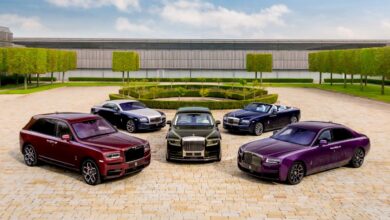16 of the World’s Most Famous Warplanes!
The world of aviation has been a theater of innovation, where engineering brilliance and strategic foresight converge. Within this realm, a few fighter jets have ascended to iconic status.
In this exploration, we will delve into the top 12 fighter jets in the world, each a marvel of its own. These aircraft have not only revolutionized aviation but have also played decisive roles in pivotal moments. Our journey through these remarkable flying machines reveals why they are honored as the best of the best.
Table of Contents
Lockheed Martin F-22 Raptor
- Origin: United States
- Year: 2005
Air dominance itself is embodied in the Lockheed Martin F-22 Raptor. Born from the U.S. Air Force’s Advanced Tactical Fighter program, the F-22 combined stealth, supersonic speed, and extreme agility, which grants it information on the battle space.
Unlike its precursors, the F-22 wasn’t just designed to survive air-to-air – it was designed to dominate it. Its supercruise capability, which lets it fly at supersonic speeds without using afterburners, provides a silent, sudden advantage in battle. The fighter jet is designed to have radar-stealth capabilities, internal weapons bays, and thrust-vectoring nozzles. This enables it to perform stunting feats that would otherwise defy conventional physics.
Featuring the AN/APG-77 AESA radar, it is capable of tracking multiple targets simultaneously without being detected by enemy systems. Expensive and with limited availability, the Raptor is unmatched in its ability to dominate the air. Today, it is held in enough reverence as an American engineering marvel as a fearsome, respected, and feared aerial ghost haunting the skies of the world.
Lockheed Martin F-35 Lightning II
- Origin: United States
- Year: 2015
As the world’s only global convention for fifth-generation fighters, F-35 is the most versatile and most widely used in the world. Unlike the generation of jets designed for Cold War superiority, the F-35 was conceived for joint capabilities, digital warfare, and cooperation worldwide.
The F-35 is a linchpin of allied defense strategy and is available in three variants – conventional-takeoff (F-35A); short-takeoff/vertical-landing (F-35B); and carrier-based (F-35C). All this to meet the unique needs of military ground, naval, and air forces in the United States and around the world.
It features the most advanced sensor suite and achieves a seamless view of the battlespace with sensors such as the revolutionary Distributed Aperture System (DAS). It’s the only one of its kind, the DAS and the world’s most advanced helmet-mounted display system – all of which provide pilots with unprecedented situational awareness of the battlespace. It enhances their ability to perform their mission and make the most of any mission, from the mundane to the epic.
What it has proved is that the F-35 deserves a place in two dozen air forces. It isn’t just a fighter, it’s a flying command node, designed for 21st-century warfare. That can work in stealth, coordinate fleets of drones, and deliver precision strikes before an enemy even knows it’s there.
Chengdu J-20 Mighty Dragon
- Origin: China
- Year: 2017
The Chengdu J-20, or “Mighty Dragon,” is China’s effort to decisively break into this rarefied territory of elite fifth-generation stealth fighters. Wrapped in secrecy and strategic ambition, the J-20 was developed to challenge Western air superiority fighters like the F-22 and F-35. It announced the arrival of a new Chinese superpower in the skies over the contested waters of the Indo-Pacific.
The long, slim profile combined with a canard-delta wing gives it exceptional high-speed performance and low radar cross-section. While early types were powered by Russian engines, the new version is powered by the indigenous WS-10C and WS-15 engines.
The J-20 is intended to perform both interceptor and strike missions, especially at longer ranges. Its continued service with the People’s Liberation Army Air Force (PLAAF) heralds a new era in the burgeoning aerospace capabilities of the Chinese. The Mighty Dragon has finally flown – not as a legend, but as a prospective player in today’s air combat realm.
Sukhoi Su-57 Felon
- Origin: Russia
- Year: 2020 (Initial service)
The Russian Su-57 “Felon” is Russia’s first stealth fighter aircraft. It’s the one that has come about amid one of the most troubled development processes for any Western or Russian weapons project for years. It was designed to improve upon India’s limited fleet of French Mirage 2000 fighters, which would have been complemented by the medium multi-role combat aircraft (MMRCA).
And unlike the stealth-centric F-35 design, the Su-57 is based on the aerodynamic Su-27 series, supplemented with internal weapons bays, radar-absorbing materials, and thrust vectoring engines. An arsenal of radar instruments is spread across multiple nodes throughout the airframe to provide 360-degree coverage – a hedge against any stealth shortcomings.
Its development was long delayed, and production is still limited, but the Su-57 is a significant technological leap for Russia. Built to fly into contested space, perform electronic warfare, slip past radar, and flick rolls through the sky with balletic defiance. The Felon represents the continuation of Russian aerospace innovation, where engineering meets and often collides with geopolitical storms.
Grumman F6F Hellcat
- Origin: United States
- Year: 1942
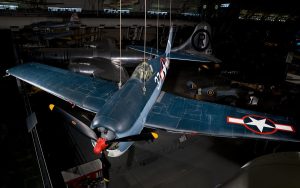
During World War II, Grumman developed the F6F Hellcat as a fighter aircraft. Initially designed as a modernized edition of the U.S. Navy’s primary fighter jet, the F4F Wildcat, the Hellcat surpassed its predecessor.
The Vought F4U Corsair, which was meant to replace the Wildcat, included a crash during its prototype development phase.
The Hellcat was a renowned fighter aircraft for its ruggedness. It also contains exceptional dive-bombing capability, and its capability to absorb damage in combat. It possessed six .50 caliber machine guns and had a top speed of over 380 mph. The Hellcat played a critical role in securing victory for the U.S. Navy in the Pacific theater.
Supermarine Spitfire
- Origin: United Kingdom
- Year: 1938
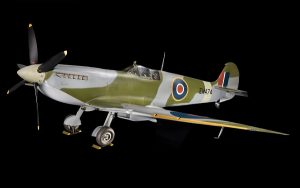
The Supermarine Spitfire is an iconic British fighter aircraft. It played a pivotal role in the Battle of Britain during World War II. With various versions featuring extended range, the Spitfire became a symbol of British resistance.
Initially, the Spitfire was one of the fighter jets for short-range home defense. However, in 1941, the RAF started conducting offensive operations over Nazi-occupied Europe. To increase the range of the Mk. V fighter, the RAF utilized jettisonable fuel tanks of 30- and 90-gallons, which could fit flush under the fuselage.
As the war extended and fewer enemy fighters were there, the Spitfires were deployed to fly ground strafing missions. To enhance the low-altitude features, most Spitfire Mk. Vs had their wingtips removed. These low-altitude fighters were classified as “L.F.” aircraft and carried the prefix “Spitfire L.F. Mk. Vc”.
Mikoyan MiG-15
- Origin: Soviet Union
- Year: 1947
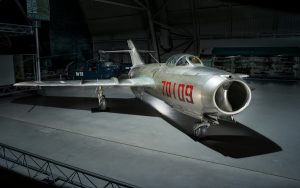
During the Korean War, the Soviet Union developed and introduced the Mikoyan MiG-15 fighter jet. They gave the fight to several communist satellite nations, including North Korea, by 1952. They also introduced the MiG-15bis, a version of the aircraft with a more powerful engine and hydraulically boosted ailerons, in 1950.
During the Korean War, both MiG-15 fighter jet’ models were extensively used against United Nations forces. It gained notoriety for its speed, agility, and swept-wing design. Armed with a 37mm cannon, it could reach speeds of around 670 mph, making it a formidable opponent.
F-16 Fighting Falcon
- Origin: United States
- Year: 1978
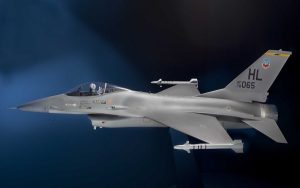
The U.S. Air Force and many other nations use the highly versatile multirole fighter. One of the first F-16s was acquired by Thunderbirds in 1982. During their transition from T-38s to F-16s, the F-16 aircraft bear the serial number 81-0663. It holds a significant place in Thunderbirds’ history.
This aircraft continued to serve the Thunderbirds until 1992 when they switched to F-16Cs. Later, it was refurbished to operational standards and allocated to the Air Education and Training Command to train pilots at Luke Air Force Base in Arizona.
In 1996, the Thunderbirds gave it a new look by painting it in their signature colors at Nellis Air Force Base in Nevada. Finally, in October 1996, the museum put it on display for public viewing. Equipped with advanced avionics, the F-16 can reach speeds exceeding 1,500 mph.
Spad XIII
- Origin: France
- Year: 1917
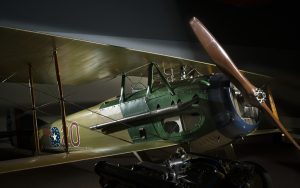
The Spad XIII was a French biplane fighter aircraft during World War I. The Spad XIII, a fast and sturdy aircraft, proved to be one of the most successful fighter jets of World War I, alongside the renowned Fokker D.VII and Sopwith Camel.
Some of the most famous air heroes of the war, including Guynemer, Fonck, Nungesser, Lufbery, Luke, and Rickenbacker, flew this aircraft.
Its robust construction and ability to dive at high speed made it one of the best dogfighting jets. Renowned for its ruggedness and firepower, it contributed significantly to the Allied air effort. The Spad XIII’s accomplishments included numerous aerial victories and its role in the air battles of WWI.
F/A-18 Super Hornet
- Origin: United States
- Year: 1999
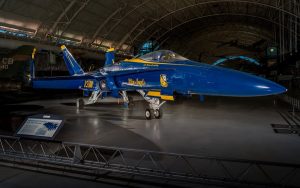
The F/A-18 Super Hornet is a multirole fighter by the U.S. Navy and Marine Corps. The aircraft has the “F/A” designation for both fighter and attack roles. It provides mission planners with exceptional flexibility.
This particular Hornet has flown various combat tours, including in Operation Desert Storm in 1991. Also, over Iraq and Afghanistan between 2007 and 2011. It was during the Global War on Terrorism campaign.
Additionally, it was also used by the Blue Angels. The Navy’s flight demonstration squadron, for an extended period, making it the most widely used aircraft type by the squadron. This versatile aircraft is capable of air-to-air combat and ground attack missions. Equipped with advanced radar systems, it can carry a wide range of air-to-air and air-to-ground munitions.
Sukhoi Su-27
- Origin: Soviet Union
- Year: 1985
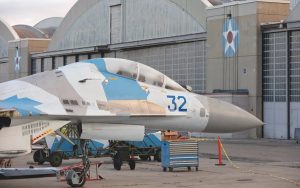
The Sukhoi Su-27 is a Russian air superiority fighter. It is celebrated for its impressive maneuverability and long-range capabilities. It was designed in the 1970s and was introduced into the Soviet Air Force in the mid-1980s.
However, the Soviet Union collapsed in 1991. Its successor state, the Russian Federation, developed various new designs to complement the original. Such as the Su-30, Su-33, Su-34 strike aircraft, and Su-37, among others.
The People’s Liberation Army Air Force built and flew the Shenyang J-11. While also developing carrier-based variants. The Su-27’s design has speeds exceeding 1,500 mph and a range of over 2,000 miles. It has influenced subsequent generations of Russian fighter aircraft.
Both sides of the current Russo-Ukraine War have used many Flankers in air-to-air engagements. Although several post-Soviet states still use the Su-27. It is unclear what the ongoing war’s outcome will be, but it is likely that the Flanker will remain in use in the skies for years to come.
Eurofighter Typhoon
- Origin: Europe (Joint project by the UK, Germany, Italy, and Spain)
- Year: 2003
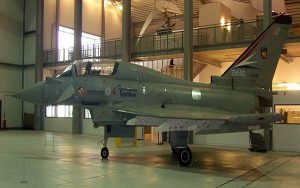
The Eurofighter Typhoon is a European multi-role fighter jet. The Typhoon F2 was originally a part of air-to-air combat. It has evolved into the FGR4 which has the ability to engage different types of targets with a variety of weapons.
The fighter jet’s advanced cockpit and hands-on throttle and stick (HOTAS) interface. It combines with the Helmet Equipment Assembly (HEA) and requires the pilot to play a crucial role in operating the Typhoon effectively.
The aircraft can execute a wide range of missions. Such as air-to-air combat and ground attack, due to its high-speed performance, advanced radar, and integration with modern weaponry.
Mikoyan MiG-31
- Origin: Soviet Union
- Year: 1975
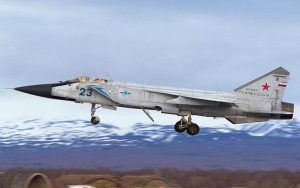
The Mikoyan MiG-31 is a Russian interceptor aircraft to defend against supersonic and hypersonic threats.
In the 1970s, engineers developed the MiG-31 as a high-speed interceptor. It counter the threat of low-flying supersonic aircraft and cruise missiles. This upgraded version of the MiG-25 supersonic fighter has a strengthened airframe for supersonic flight. Specifically at low altitudes, new engines, and a more powerful tracking radar, even though it bears some resemblance to the MiG-25.
The MiG-31B series replaced older MiG-25 models. It was introduced in 1983 as the MiG-31 ‘Foxhound-A,’ featuring various avionics updates. Engineers proposed advanced models such as the MiG-31M with improved avionics and weapons. A few were built and the aircraft never entered service.
It is capable of speeds exceeding Mach 2.8. That makes it one of the fastest military fighter jets globally. Additionally, the MiG-31 is equipped with powerful radar and air-to-air missiles.
Saab JAS 39 Gripen
- Origin: Sweden
- Year: 1996
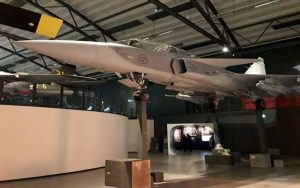
The Saab Gripen is a Swedish multirole fighter possessing affordability and versatility. The Gripen aircraft was designed to replace the old Viggen and Draken fighter jets in Sweden.
The Gripen program was aiming to create a fully multi-role plane that could perform an entire range of missions. It includes fighter, attack, and reconnaissance. The JAS 39 designation, which stands for Jakt (Fighter), Attack, and Spaning (Reconnaissance), reflects this philosophy.
The development of the Gripen was managed by a consortium of Swedish companies, called Industrigruppen (IG). The Gripen has been a commercial success. It features advanced avionics and can perform air-to-air, air-to-ground, and reconnaissance missions. The Gripen’s design emphasizes ease of maintenance and cost-effectiveness.
Mitsubishi A6M Zero
- Origin: Japan
- Year: 1940
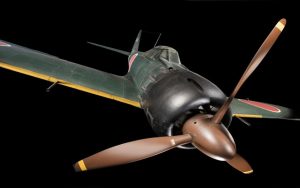
The Mitsubishi A6M Zero is the most renowned symbol of Japanese air power during World War II. It was the primary adversary of the Allies in the Pacific air war.
Its first flight was in April 1939 by Mitsubishi, Nakajima, Hitachi, and the Japanese Navy from 1940-1945. It was with a total production of 10,815 units, the highest of any fighter jet. Its unique design and historical significance make it an important asset in air power history.
Zeros were extensively used in kamikaze attacks, particularly during the battle for the Philippines in October 1944. The Zero featured a lightweight design and a single 20mm cannon. It was known for its exceptional range and maneuverability. That makes it a formidable opponent early in the war.
Messerschmitt Bf 109
- Origin: Germany
- Year: 1935
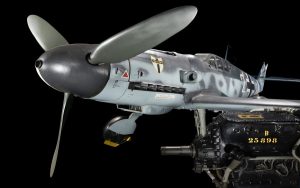
The Messerschmitt Bf 109 was a German fighter aircraft during World War II. The Bayerische Flugzeugwerke submitted the Messerschmitt Bf 109 as an entry in a fighter competition. It was held by the German Air Force in the early 1930s.
The aircraft boasted advanced aerodynamics and incorporated features. Such as retractable landing gear, an enclosed cockpit, automatic slats, cantilever wings, and stressed skin construction.
During the competition, it outperformed its larger and heavier rival, Heinkel’s He 112. The Bf 109B, the first production model, began rolling off the production lines in 1936. The Bayerische Flugzeugwerke AG was renamed the Messerschmitt AG in 1938. The aircraft retained the official Luftwaffe designation of Bf 109 throughout the war, even though many referred to it as the Me 109. Highly maneuverable and with a long production history, it featured various versions and upgrades. The Bf 109 was the backbone of the Luftwaffe during the early years of the war.
Take Aways
These fighter jets are remarkable for their individual strengths and contributions to aviation history. They’ve each played pivotal roles in shaping the course of military aviation. From World War I to the modern era, these fighter jets set benchmarks in design, technology, and performance for their respective time periods.
Each of the fighter jets has etched its own unique narrative in the tapestry of aviation history. We have a profound appreciation for the relentless spirit of innovation and excellence that has shaped these legendary aircraft.
Behind the metal and engines are the visionary engineers, courageous pilots, and strategic leaders who transformed these aircraft into legends. There are several jobs other than pilots that are of remarkable strength and are the highest paying jobs such as Air Traffic Controller.
The legacies of these aircraft are not merely mechanical; they are a testament to human ingenuity and resolve. These machines continue to inspire awe, standing as symbols of what humanity can achieve when it reaches for the skies and beyond. The stories of these aircraft will forever soar, undetectable by time, in the skies and the hearts of aviation enthusiasts, reminding us of the heights to which human imagination and dedication can ascend.
